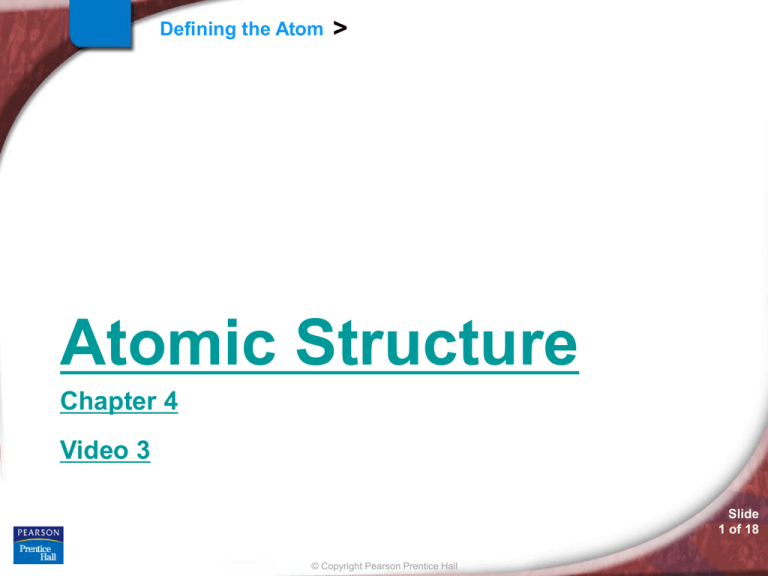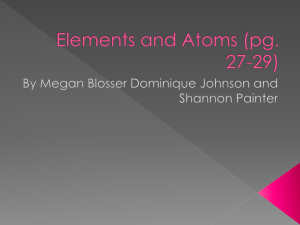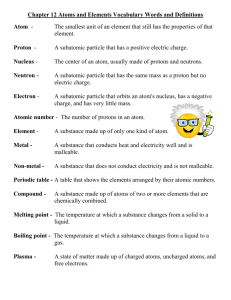
Defining the Atom
>
Atomic Structure
Chapter 4
Video 3
Slide
1 of 18
© Copyright Pearson Prentice Hall
4.1
Defining the Atom
> Early Models of the Atom
Early Models of the Atom
• An atom is the smallest particle of an element
that retains its identity in a chemical reaction.
• Philosophers and scientists have proposed
many ideas on the structure of atoms.
Slide
2 of 18
© Copyright Pearson Prentice Hall
4.1
Defining the Atom
> Early Models of the Atom
Democritus’s Atomic Philosophy
How did Democritus describe atoms?
Democritus
Slide
3 of 18
© Copyright Pearson Prentice Hall
4.1
Defining the Atom
> Early Models of the Atom
Democritus believed that atoms were
indivisible and indestructible.
Democritus’s ideas were limited because
they didn’t explain chemical behavior and
they lacked experimental support.
Slide
4 of 18
© Copyright Pearson Prentice Hall
4.1
Defining the Atom
> Early Models of the Atom
Dalton’s Atomic Theory
How did John Dalton further
Democritus’s ideas on atoms?
Slide
5 of 18
© Copyright Pearson Prentice Hall
4.1
Defining the Atom
> Early Models of the Atom
By using experimental methods, Dalton
transformed Democritus’s ideas on atoms
into a scientific theory.
The result was Dalton’s atomic theory.
Slide
6 of 18
© Copyright Pearson Prentice Hall
4.1
Defining the Atom
> Early Models of the Atom
All elements are composed of tiny indivisible
particles called atoms.
Slide
7 of 18
© Copyright Pearson Prentice Hall
4.1
Defining the Atom
> Early Models of the Atom
Atoms of the same element are identical. The
atoms of any one element are different from
those of any other element.
Slide
8 of 18
© Copyright Pearson Prentice Hall
4.1
Defining the Atom
> Early Models of the Atom
Atoms of different elements can physically mix
together or can chemically combine in simple
whole-number ratios to form compounds.
Slide
9 of 18
© Copyright Pearson Prentice Hall
4.1
Defining the Atom
> Early Models of the Atom
Chemical reactions occur when atoms are
separated, joined, or rearranged. Atoms of one
element are never changed into atoms of
another element in a chemical reaction.
Slide
10 of 18
© Copyright Pearson Prentice Hall
Defining the Atom
>
Atoms are solid and
indivisible
Solid Ball- no Parts
Slide
11 of 18
© Copyright Pearson Prentice Hall
4.1 Section Quiz
Assess students’ understanding
of the concepts in Section 4.1.
Continue to:
-or-
Launch:
Section Quiz
Slide
12 of 18
© Copyright Pearson Prentice Hall
4.1 Section Quiz
1. The ancient Greek philosopher credited with
suggesting all matter is made of indivisible
atoms is
a. Plato.
b. Aristotle.
c. Democritus.
d. Socrates.
Slide
13 of 18
© Copyright Pearson Prentice Hall
4.1 Section Quiz
2. Dalton's atomic theory improved earlier
atomic theory by
a. teaching that all matter is composed of tiny
particles called atoms.
b. theorizing that all atoms of the same
element are identical.
c. using experimental methods to establish a
scientific theory.
d. not relating atoms to chemical change.
Slide
14 of 18
© Copyright Pearson Prentice Hall
4.2
Subatomic Particles
Subatomic Particles
What are three kinds of subatomic particles?
Slide
15 of 18
© Copyright Pearson Prentice Hall
4.2
Structure of the Nuclear Atom
>
Subatomic Particles
Three kinds of subatomic particles are
electrons, protons, and neutrons.
Slide
16 of 25
© Copyright Pearson Prentice Hall
4.2
Structure of the Nuclear Atom
>
Subatomic Particles
Electrons
In 1897, the English physicist J. J. Thomson
(1856–1940) discovered the electron. Electrons
are negatively charged subatomic particles.
Slide
17 of 25
© Copyright Pearson Prentice Hall
4.2
Structure of the Nuclear Atom
>
Subatomic Particles
Thomson performed experiments that involved
passing electric current through gases at low
pressure.
The result was a glowing beam, or cathode ray,
that traveled from the cathode to the anode.
Slide
18 of 25
© Copyright Pearson Prentice Hall
4.2
Structure of the Nuclear Atom
>
Subatomic Particles
Cathode Ray Tube
Slide
19 of 25
© Copyright Pearson Prentice Hall
4.2
Structure of the Nuclear Atom
>
Subatomic Particles
A cathode ray is deflected by a magnet.
Slide
20 of 25
© Copyright Pearson Prentice Hall
4.2
Structure of the Nuclear Atom
>
Subatomic Particles
A cathode ray is deflected by electrically
charged plates.
Slide
21 of 25
© Copyright Pearson Prentice Hall
4.2
Structure of the Nuclear Atom
>
Subatomic Particles
Thomson concluded that a cathode ray is a
stream of electrons. Electrons are parts of the
atoms of all elements.
Slide
22 of 25
© Copyright Pearson Prentice Hall
Structure of the Nuclear Atom
>
Slide
23 of 25
© Copyright Pearson Prentice Hall
4.2
Structure of the Nuclear Atom
>
Subatomic Particles
Protons and Neutrons
In 1886, Eugen Goldstein (1850–1930) observed
a cathode-ray tube and found rays traveling in
the direction opposite to that of the cathode rays.
He concluded that they were composed of
positive particles.
Such positively charged subatomic particles are
called protons.
Slide
24 of 25
© Copyright Pearson Prentice Hall
Structure of the Nuclear Atom
>
Plum Pudding Model
Slide
25 of 25
© Copyright Pearson Prentice Hall
Structure of the Nuclear Atom
>
Robert A. Millikan (1868 – 1953)
Millikan used the experimental evidence of
Thomson and carried out further experiments
that resulted in the calculation of the mass of
the electron. The mass of the electron is
1/1840 that of a hydrogen atom and the
electron has a unit negative charge.
Slide
26 of 25
© Copyright Pearson Prentice Hall
Structure of the Nuclear Atom
>
Eugene Goldstein (1850 – 1930)
Observed a cathode ray tube and found rays
traveling in the opposite direction to the
cathode rays. Such positively charged
subatomic particles are called protons. Each
proton has a mass about 1840 times that of
an electron.
Slide
27 of 25
© Copyright Pearson Prentice Hall
4.2
Structure of the Nuclear Atom
>
Subatomic Particles
In 1932, the English physicist James Chadwick
(1891–1974) confirmed the existence of yet
another subatomic particle: the neutron.
Neutrons are subatomic particles with no
charge but with a mass nearly equal to that of a
proton.
Slide
28 of 25
© Copyright Pearson Prentice Hall
4.2
Structure of the Nuclear Atom
>
Subatomic Particles
Table 4.1 summarizes the properties of
electrons, protons, and neutrons.
Slide
29 of 25
© Copyright Pearson Prentice Hall
4.2
Structure of the Nuclear Atom
>
The Atomic Nucleus
The Atomic Nucleus
How can you describe the structure of
the nuclear atom?
Slide
30 of 25
© Copyright Pearson Prentice Hall
4.2
Structure of the Nuclear Atom
>
The Atomic Nucleus
Ernest Rutherford’s Portrait
Slide
31 of 25
© Copyright Pearson Prentice Hall
4.2
Structure of the Nuclear Atom
>
The Atomic Nucleus
Rutherford’s Gold-Foil Experiment
In 1911, Rutherford and his coworkers at the
University of Manchester, England, directed a
narrow beam of alpha particles at a very thin
sheet of gold foil.
Slide
32 of 25
© Copyright Pearson Prentice Hall
4.2
Structure of the Nuclear Atom
>
The Atomic Nucleus
Rutherford’s Gold-Foil Experiment
Slide
33 of 25
© Copyright Pearson Prentice Hall
4.2
Structure of the Nuclear Atom
>
The Atomic Nucleus
Alpha particles scatter from the gold foil.
Slide
34 of 25
© Copyright Pearson Prentice Hall
4.2
Structure of the Nuclear Atom
>
The Atomic Nucleus
Rutherford’s Gold-Foil Experiment
Slide
35 of 25
© Copyright Pearson Prentice Hall
4.2
Structure of the Nuclear Atom
>
The Atomic Nucleus
The Rutherford Atomic Model
Rutherford concluded that the atom is mostly
empty space. All the positive charge and almost
all of the mass are concentrated in a small region
called the nucleus.
The nucleus is the tiny central core of an atom
and is composed of protons and neutrons.
Slide
36 of 25
© Copyright Pearson Prentice Hall
4.2
Structure of the Nuclear Atom
>
The Atomic Nucleus
In the atom, the protons and neutrons
are located in the nucleus.
The electrons are distributed around
the nucleus and occupy almost all the
volume of the atom.
Slide
37 of 25
© Copyright Pearson Prentice Hall
4.2 Section Quiz
Assess students’ understanding
of the concepts in Section 4.2.
Continue to:
-or-
Launch:
Section Quiz
Slide
38 of 25
© Copyright Pearson Prentice Hall
4.2 Section Quiz
1. Which of the following is NOT an example of
a subatomic particle?
a. proton
b. molecule
c. electron
d. neutron
Slide
39 of 25
© Copyright Pearson Prentice Hall
4.2 Section Quiz
2. The nucleus of an atom consists of
a. electrons only.
b. protons only.
c. protons and neutrons.
d. electrons and neutrons.
Slide
40 of 25
© Copyright Pearson Prentice Hall
4.2 Section Quiz
3. Most of the volume of the atom is occupied
by the
a. electrons.
b. neutrons.
c. protons and neutrons.
d. protons.
Slide
41 of 25
© Copyright Pearson Prentice Hall
Neils Bohr (1885-1962)
Was a young Danish physicist and a student of
Rutherford’s when he proposed that the electron
is only found in specific circular paths, or orbits,
around the nucleus. This model of the atom is
similar to the solar system because the
electrons orbit the nucleus like the planets orbit
the sun. Each electron orbit in Bohr’s model has
a fixed energy level.
Slide
42 of 25
© Copyright Pearson Prentice Hall
Slide
43 of 25
© Copyright Pearson Prentice Hall
Slide
44 of 25
© Copyright Pearson Prentice Hall
Each energy level can hold a certain number of electrons.
•
•
•
•
Level one can only hold 2 e’s,
Level two holds 8 e’s,
Level 3 can hold a maximum of 18 e’s
Level four holds 32 e’s.
The energy of the electrons increases as the
levels increase. When electrons lose energy they
go down a level and when electrons gain energy
they go to a higher level.
Slide
45 of 25
© Copyright Pearson Prentice Hall
END OF SHOW






